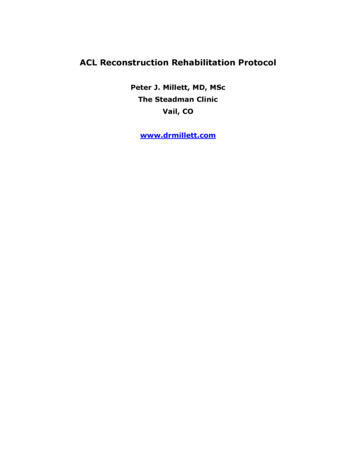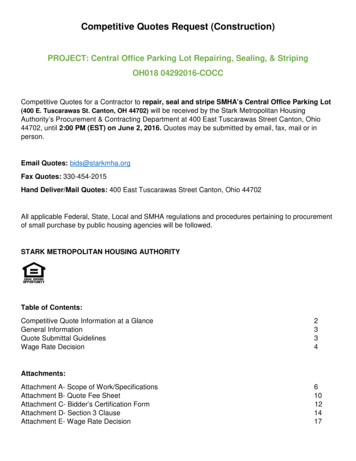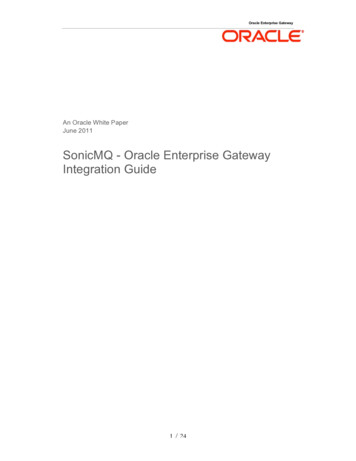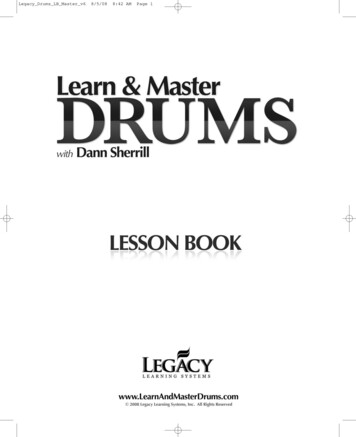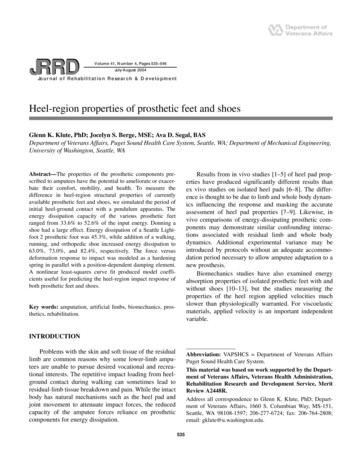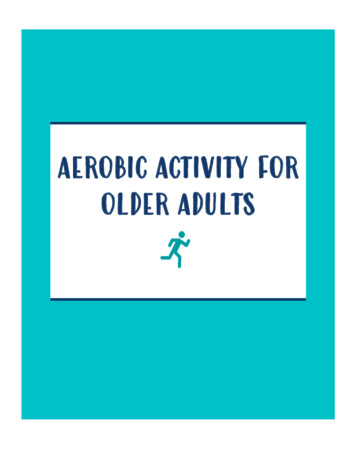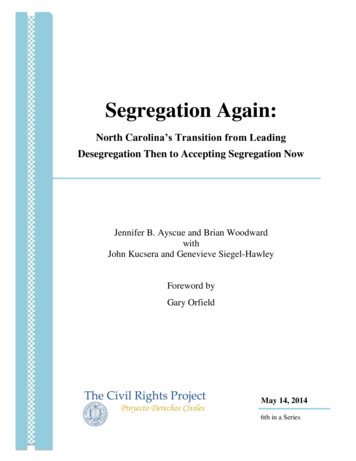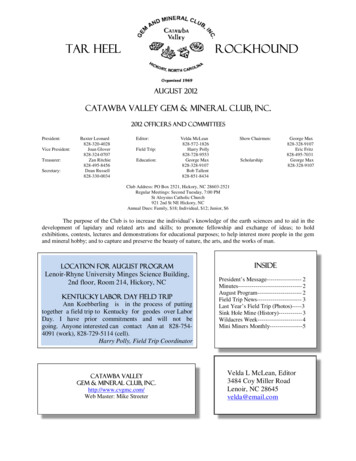
Transcription
Tar HeelRockhoundAugust 2012Catawba Valley Gem & Mineral Club, Inc.2012 Officers and CommitteesPresident:Vice President:Treasurer:Secretary:Baxter Leonard828-320-4028Joan Glover828-324-0707Zan Ritchie828-495-8456Dean Russell828-330-0034Editor:Field Trip:Education:Velda McLean828-572-1826Harry Polly828-728-9553George Max828-328-9107Bob Tallent828-851-8434Show Chairmen:Scholarship:George Max828-328-9107Eric Fritz828-495-7031George Max828-328-9107Club Address: PO Box 2521, Hickory, NC 28603-2521Regular Meetings: Second Tuesday, 7:00 PMSt Aloysius Catholic Church921 2nd St NE Hickory, NCAnnual Dues: Family, 18; Individual, 12; Junior, 6The purpose of the Club is to increase the individual’s knowledge of the earth sciences and to aid in thedevelopment of lapidary and related arts and skills; to promote fellowship and exchange of ideas; to holdexhibitions, contests, lectures and demonstrations for educational purposes; to help interest more people in the gemand mineral hobby; and to capture and preserve the beauty of nature, the arts, and the works of man.Location for August ProgramLenoir-Rhyne University Minges Science Building,2nd floor, Room 214, Hickory, NCKentucky Labor Day FieldField TripAnn Koebberling is in the process of puttingtogether a field trip to Kentucky for geodes over LaborDay. I have prior commitments and will not begoing. Anyone interested can contact Ann at 828-7544091 (work), 828-729-5114 (cell).Harry Polly, Field Trip CoordinatorCatawba ValleyGem & Mineral Club, Inc.Inchttp://www.cvgmc.com/Web Master: Mike StreeterInsidePresident’s Message------------------ 2Minutes--------------------------------- 2August Program----------------------- 2Field Trip News----------------------- 3Last Year’s Field Trip (Photos)-----3Sink Hole Mine (History)------------ 3Wildacres Week----------------------- 4Mini Miners Monthly-----------------5Velda L McLean, Editor3484 Coy Miller RoadLenoir, NC 28645velda@email.com
President’s MessageBaxter Leonard, Club PresidentAugust is a warm to hot month, and eventhough we may not be as active outdoors, we shouldstart thinking of our annual indoor event March2013--i.e. our mineral/jewelry/fossil show. Let usbring up subjects at this month's meeting concerninga central theme or special display for the show. Allmembers have seen someone or some subject thatwould attract the attention and interest of the publicand we need to decide what that particulartheme/subject is appropriate for next year's show.It is fortunate that our club has a balance ofmembers interested in the various facets of our hobbywhich may include: minerals, fossils, lapidary. Thetheme may not be limited to one subject, or it may bevery specific in subject matter. It may be organizedby a club member, or it may involve an outsideperson who is not a club member. So everyone giveconsideration for this between now and the meeting,and let us have many ideas to review.Old Business: No old business.New Business: The August 14th Club meeting will beheld in room 214 in the Minges Science Building onthe Lenior-Rhyne University campus at 7:00 PM.General Information: Grassy Creek Show wasmentioned. Also mentioned was the once a yearopportunity to collect Bisbee Turquoise on Oct 14,2012 in Bisbee, AZ. Contact the Bisbee Mining &Historical Museum for information. There are only100 slots to collect available.Scholarship Committee: Anthony Frushour wasawarded the Club Scholarship after a motion byGeorge Max and seconded by Harry Polly andapproved by the club membership. A club member,Anthony, is studying Geology at Appalachian StateUniversity.Closing of Business: The meeting adjourned at 7:30PM.Program: Ron Ruschman gave a presentation onArizona minerals. Ron is an annual vendor at theclub’s show.Baxter LeonardCatawbaCatawba ValleyGem and Mineral Club, Inc.Minutes for July 10, 2012The July 10, 2012 meeting of the CVGMCwas called to order by President Baxter Leonard at7:00 PM. There were 34 members and guests present.Minutes from the May 2012 meeting were approvedby the club. Motion was made by Larry Huffman,seconded by Harry Polly, and approved by the club.Treasurer Report: Zan Ritchie asked if any memberwould be willing to assume the upcoming role oftreasurer. Terry Russell volunteered. Zan and Terrywill work together on the transition. Zan also wantedto remind club members that the club projector isavailable to borrow. Just contact Zan to makearrangements.Field Trip Report: A field trip has been organizedfor the Ray Mine on 7-20-2012.Show Committee: No report.Education Committee: The Van Oak and Maidenschools were visited in May and five programs werepresented.August 2012Respectfully submitted,Dean Russell, SecretaryAugust ProgramJoan Glover, Program DirectorGeorge Max will discuss properties ofglass and demonstrate glass blowing artistry.Location: Lenoir-Rhyne University MingesScience Building, 2nd floor, Room 214.Parking: The restricted parking lots andparking spaces around Minges ScienceBuilding should be available for our use,since summer school will not be in session.UnfamiliarwithLenoir-RhyneUniversity? Come to our usual meeting roomat St. Aloysius, and a Gem Clubrepresentative can guide you to the correctmeeting place at Lenoir-Rhyne.Joan GloverTar Heel RockhoundPage 2
Field Trip NewsSink hole MineHarry Polly, Field Trip CoordinatorThe August field trip will be to the Sink HoleMine in Mitchell County. We will meet at 8:00 amin the parking lot of the BBQ Man in Hudson,NC. This is the large PINK Quonset hut sitting onthe hill past Caldwell Community College. You willneed hammers, chisels, crack hammer or sledge,collecting buckets, food, water, and rain gear. Ashovel is sometimes needed. There are no facilitiesand no food places close by. This is a good place toget grab bag material. There are no restrictions onhow much to collect and there is no feeinvolved. Material found here is feldspar, garnet,apatite, mica, quartz, beryl. The best specimens arethe apatite with garnet interspersed.Harry PollyLast Year’s Field TripThe Sink HoleMine in Mitchell Countywas one of numerous minesin western North Carolinathat originally were workedbyAmericanIndiansbefore the arrival of whitesettlers. It therefore waspredominantly used formining mica. Commercialmica production began in 1867 and continued on a massscale until the 1960s, when the development of solid stateelectronics led to a decrease in the need for sheet mica.The remains of the Sink Hole Mine are still evident, aboutfour miles southeast of Bakersville.Mica is composed of a group of aluminumsilicates is common in the Blue Ridge Mountains andwestern Piedmont. Since the 1870s, North Carolina mineshave produced the majority of mica in the United States.Sheet mica initially was used as a form of window glass,and then as an insulator for electrical equipment.Additionally, in the early 1900s, scrap mica became apopular product as a friction-causing agent.There is evidence of mining for a variety ofminerals in North Carolina far before the development ofmodern mining. Although information about earlierminers is lacking, it is believed that mining began prior to1500. Modern mining in Mitchell County, specifically,was developed in the trenches and mining pits already dugby Indians. Prospectors in western North Carolina fromthe 1860s expanded upon older mines and developed aformidable industry.Senator Thomas L. Clingman established thelocation for the modern Sink Hole Mine, having beenhired by a New York mica dealer to investigate theaccessibility of the mineral. As word of successful miningspread, mica operations were set up in Buncombe,Haywood, Jackson, Yancey and Macon Counties. Themining of mica in North Carolina became hugelysuccessful, eventually making the state the dominantsource of mica in the nation.References:Jasper Leonidas Stuckey, North Carolina: Its Geology andMineral Resources (1965)Bill Sharpe, A New Geography of North Carolina, I (1954)John P. Arthur, Western North Carolina: A History (1914)William S. Powell, ed., Encyclopedia of North Carolina (2006)Mitchell County Board of Education, “Discovering MitchellCounty” (1939)http://www.ncmarkers.com/Markers.aspx?ct ddl&sp search&k Markers&sv N-7%20-%20SINK%20HOLE%20MINEAugust 2012Tar Heel RockhoundPage 3
WildacresWildacres Weekby Anne Lynn Benson,Wildacres Spring Scholarship RecipientThe 40th annualSpring EFMLS Workshopat Wildacres was fabulous!My dream of attendingfinally came true April 10thru 15 when, thru thegenerosity of the EFMLSWildacresWorkshopCommittee and its supporters, I became therecipient of a scholarship tothe Wildacres Retreat. Athousand thank-yous toeveryone who made thiswonderful week possible.In my nearly 30 years with the Delaware Valley EarthScience Society (DVESS), I’ve amassed many minerals, fossilsand even rocks I’d love to wear as jewelry; the beginning andintermediate Wire Wrapping classes I took gave me the skill tobegin making this dream come true. Wildacres instructorsvolunteer their time and are reimbursed travel expenses; myteacher was master wire jewelry artisan Jan gh the week began quite cool and windy, by thethird day temperatures had warmed into the 70’s. The view fromthe patio was crystal clear and the dogwoods, rhododendronsand other flowers were beautiful; the Hiking Class even foundtrilliums in bloom. Hearty meals were served family style by acheerful kitchen staff.Lawyer, writer, mineral dealer (Octahedron Minerals)and Baltimore Chronicle editor Alice Cherbonnier was mytravelling companion. We had a grand time getting to knoweach other. Later this year we’ll be taking a Field Trip to Alice’shome in Towson, MD to see her collection and do some “silverpicking”.Speaker-in-Residence Jeff Scovil gave our group of 60participants six colorful and fantastic talks including one on histechnique for photographing minerals and gems. Jeff also tookclasses in silversmithing and produced some very nice piecesdespite having undergone hip replacement surgery less than amonth ago!YOU can join in the fun by registering for theSeptember 3 - 9 session. Speaker-in-Residence Julian Gray isbusy preparing his talks; the wide variety of wonderful classesincludes faceting, soapstone carving, micromounting and gemtrees with outstanding instructors and the usual “good stuff”auction, field trip, tailgate sale and “phun” night. Considersigning up! Registration and additional info can be found in theEFMLS Newsletter:Jeff Scovil - Master PhotographerBreathtaking, stunning and meticulous are the firstwords my brain could grasp after I caught my breath each timeone of Jeff Scovil’s photographs appeared on the screen duringhis six presentations at the Spring 2012 Wildacres Workshop.Jeff travels the world, staying days and weeks at the homes ofmineral collectors to photograph their million-dollar collections.His pictures have appeared on eleven posters for the TucsonGem & Mineral Show, in Peterson Field Guides, and severalother mineral books; his own Photographing Minerals, Fossils,and Lapidary Arts (Geoscience Press, 1996) is the only bookever written on the subject. He has been running the Seminar inMineral Photography at the Tucson show for 20 years, and wasthe 2007 recipient of the Carnegie Mineralogical Award.EFMLS News -- June-July, 2012Flowers of theMineralMineral KingdomCentral PA Rock & Mineral ClubThe Central Pennsylvania Rock and Mineral Clubwishes to invite you to join us for our 47th Annual Gem,Mineral and Jewelry Show and 62nd EFMLS ConventionSeptember 15-16, in Harrisburg, Pennsylvania. TheEFMLS Convention activities take place Friday,September 14, thru Sunday, September 16, 2012. It hasbeen 12 years since our club hosted the EFMLSconvention. At that time the EFMLS was celebrating its50th b.pdfAugust 2012Tar Heel RockhoundPage 4
Can Light Go Through Minerals?There are many different ways to describe the look andthe physical properties of a mineral. Some of these have to bedone using special equipment (like specific gravity which youcan read about in this issue. To measure specific gravity youneed a “Jolly Balance”). To measure hardness you need a set ofminerals in the Mohs’ Hardness Scale. However, color isdetermined simply by looking at the mineral and describing thecolor. Another description that you can do with the mineralspecimens in your collection is Transparency. Transparency isa description of how much light goes through a particularmineral. This is very easy, and includes only three simplecategories. Here they are:TransparentA mineral is described astransparent if light travels through it.Quartz crystal, beryl (like emerald andaquamarine), some specimens of gypsum,and some specimens of calcite can bedescribed as transparent. When you hold them up to a light, you can seeright through them as if they were pieces of clear, perfect glass.TranslucentA mineral is described as translucent if light canpass through it, but you can’t see through it because thereare inclusions or other things inside the specimen. You cansee shapes and shadows through the specimen, but notclear objects. Minerals that are sometimes transparent can,very often, be translucent. Other examples of translucentminerals are tourmaline, some quartz, calcite and fluoritespecimens, etc.OpaqueA mineral is described as opaque if itdoesn’t let any light pass through it at all, evenwhen it is sliced into thin pieces. Examples ofopaque minerals include galena, pyrite,sphalerite, marcasite, etc.Go to the specimens in yourcollection and try to look through them. Are they transparent,translucent or opaque? This can be a challenging project. Thereare some specimens that are translucent. However, on a very,very thin edge of a crystal, you may be able to see right throughthat edge. You may end up describing the specimen as“translucent (with some transparent edges).”Also, keep in mind that there are surprises in themineral world. Minerals like sphalerite are nearly alwaysopaque. But once in a rare while, a unique and wonderfulspecimen is found that, on a thin edge, is translucent! On theother hand, some mineral species, like galena and pyrite, areopaque and will never, ever be translucent. Have fun. If youkeep a catalog of your specimens and their properties, analyzethem and write down the “Transparency” of each specimen. 2012 Darryl PowellAugust 2012What is “Specific Gravity”?When you look at an entry for a mineral in a mineralhandbook or textbook, you will see a listing of that mineral’s physicalproperties. When the properties are listed, the name of each propertyisn’t always written out. So, instead of seeing “Hardness 2.5” youmight see “H: 2.5”. Another physical property that is not usuallywritten out is “Specific Gravity.” It is usually written in a short form as“Sp. Gr. ” or “SpGr ” and some books just write“gravity”.What is “Specific Gravity”? Many mineral collectors thinkthat it has something to do with the weight of a mineral. The specificgravity of a mineral will affect its weight. But remember, the size of aspecimen also affects the weight. A quartz specimen the size of yourhand may weigh a pound or less. A quartz crystal the size of an adulthuman will weigh hundreds of pounds.“Specific Gravity” is actually a comparison. It is acomparison between the weight of a mineral and the weight of anequal amount of water. In other words, specific gravity is a number thattells you how many times more a particular mineral species weighsthan the same amount of water.Here’s a better way of understanding“Specific Gravity.” The specific gravity of silveris 10. If you had a bucket of silver and a bucket ofwater that is exactly the same size, and bothbuckets are filled right up to the top, the bucket ofsilver will weigh 10 times as much as the bucketof water. Here’s another example. If you have thesame bucket of water, and now you have next to ita bucket of the same size filled with calcite, thecalcite will weigh about 2 1/2 times as much asthe bucket of water.Now you try it. The mineral fluorite hasa specific gravity of 3.4. This means a bucket offluorite weighs 3.4 times as much as an equalbucket of water. Metallic minerals, like galena,pyrite, and hematite have higher specific gravitiesthan minerals that don’t contain metals (like leadand iron). Galena’s specific gravity is 7.5. So(here we go again) a bucket of galenaweighs.you got it 7.5 times as much as anequal bucket full of water.The mineral with the highest specificgravity is platinum. The specific gravity of pureplatinum is 21.5. If you were rich enough to buy abucket of pure platinum, it would weigh howmany times an equal bucket of water? That’sright, 21.5 times as much!To the left is a picture of a piece oflaboratory equipment that was invented tomeasure specific gravity. It is called a “Jolly Balance.” It is called thisnot because it makes you happy, but after its inventor, a Germanphysicist named Philipp von Jolly. It is designed so that you can firstmeasure the weight of a piece of a mineral in air, and then the weightwhen the same specimen is place in a cup of water. Then, the followingformula is used to determine the specific gravity:Weight of Mineral in Air(Weight of Mineral in Air) - (Weight of Mineral in Water)Tar Heel RockhoundPage 5
First Class MailTar HeelRockhoundOfficial Publication ofCatawba ValleyGem and Mineral Club, Inc.Volume 41Number 8Tar Heel RockhoundVelda McLean, EditorPost Office Box 2521Hickory, North Carolina 28603-2521http://www.cvgmc.com/Club MeetingTuesdayAugust 14, 20127:00 PMLenoir-Rhyne UniversityMinges Science Building2nd floor Room 214,Hickory, NCUnfamiliar with Lenoir-Rhyne University?Come to our usual meeting room atSt. Aloysius, and aGem Club representative can guide youto the correct meeting place at Lenoir-Rhyne.
Velda L McLean, Editor 3484 Coy Miller Road Lenoir, NC 28645 velda@email.com Tar Tar Tar Heel HeelHeel RockhoundRockhoundRockhound
